The former Jacoby Mental Hospital in Bendorf-Sayn
Jewish Care- und Nursing Home for the Mentally Ill (1869 - 1942)
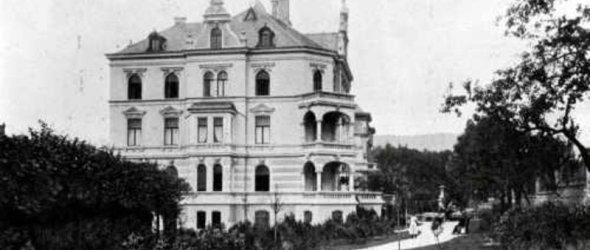
The mental hospitals founded in Bendorf by Dr. Erlenmeyer (1848) and Dr. Brosius (1857) seem to have often accommodated Jewish patients. Meier Jacoby, a merchant living in Sayn, based his application for a license to establish a Jewish asylum on the words: "I have often heard that mentally ill patients who have grown up in strict Jewish households will only partake of non-kosher food with great reluctance, that they even refuse such food completely or believe that they sin by consuming it, that they are ridiculed for their beliefs by less-educated patients or warders etc. - such circumstances must surely have a detrimental effect on mentally ill patients." Note [1]
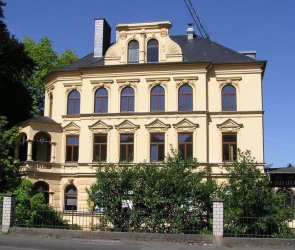
Meier Jacoby began by housing a few patients in his own home and entrusted their care to a doctor practising in Bendorf. The institution quickly grew when Jacoby bought a large property in the Koblenz-Olper-Strasse. In 1890 it already had 109 patients; roughly a third of them originated from neighbouring European countries. Note [2] On January 1, 1911 there were 163 patients (87 men and 76 women).
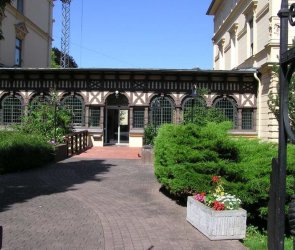
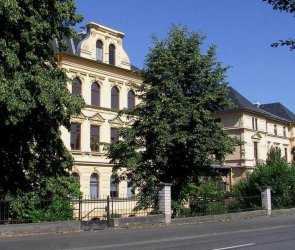
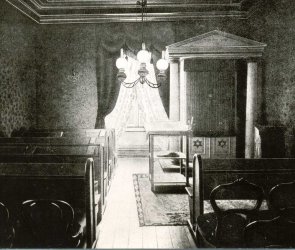
There followed more differentiation between various kinds of patients, and new buildings were constantly added. The first main building and the adjoining wards were demolished in the 1960s. Of the two main buildings which still characterise the Koblenz- Olper-Strasse, the one facing Sayn, comprising a hall and a synagogue (see illustr. 5) dates from 1881/82. The low half-timbered building, housing the winter garden and the "Kurhaus" (where treatment was offered) built in a modern villa style, was added in 1898/99. The equally impressive residence of the Jacoby family is situated in the Engerser Landstrasse (now house no.3). The lithograph (illustr. 6) gives an overview of the Jacoby Institute in the year 1900.
In the third generation of the family Dr. Fritz Jacoby and Dr. Paul Jacoby constituted the medical team supervising the institute. Their brother Manfred, who was destined to run the business side of the institute, fell in 1915 as a German soldier.
During the first years of National Socialism the Jacoby Institute was left in relative peace; probably as an acknowledgement of the fact that it was an important employer for Sayn and the region. At the end of 1938 all non-Jewish employees had to be dismissed, apart from three. They were replaced by Jewish supporting staff, people who had lost their own jobs; many of them wanted to be trained there for agricultural jobs, so that they could emigrate to Palestine.
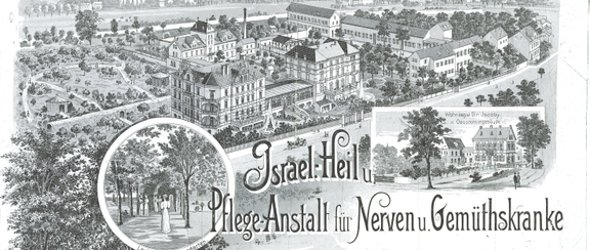
In June 1940 the Jacoby family was able to emigrate to Uruguay, via the Soviet Union and Japan. Their property was confiscated, and the administration was assigned to the Reichsvereinigung of the Jews in Germany. This was a coerced merger of Jews brought about by the National Socialists, and was only able to carry out orders. A circular decree issued by the Ministry of the Interior on 12th December 1940 decreed that "mentally ill Jews" were only to be accommodated in Sayn because "a cohabitation of Germans and Jews is not acceptable in any length of time" (illustr. 7).
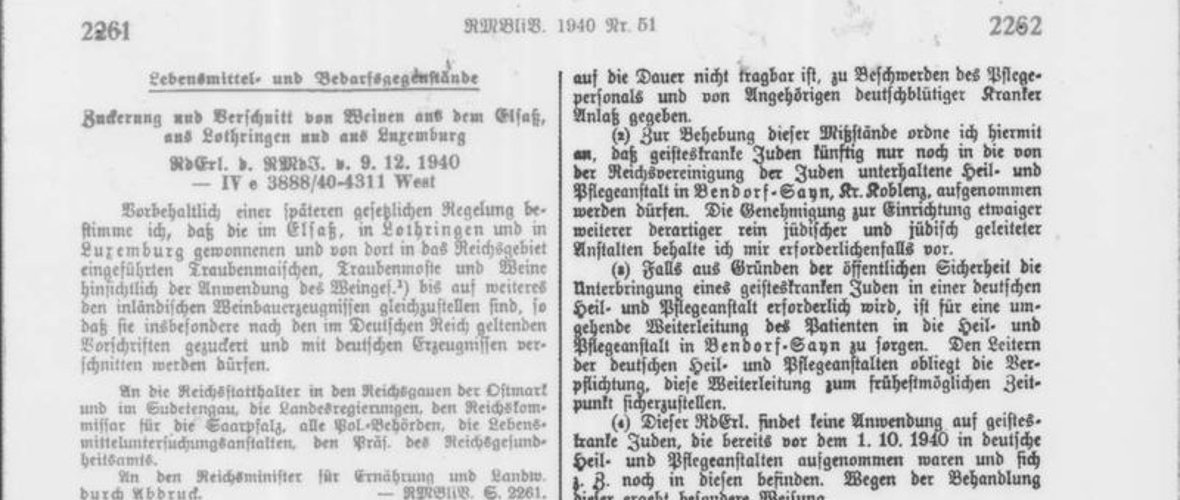
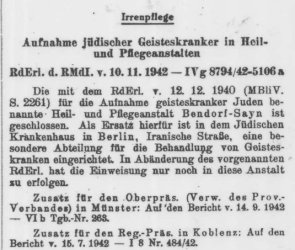
The option of concentrating all the patients in one location served as preparation of their deportation. In the course of five transports (between March and November 1942) 573 people were taken to the death camps in the East. 142 Jews died from 1940 till 1942 and were buried in the Jewish Cemetery in Sayn; most of them had already been seriously ill when they arrived in Sayn and not fit to travel.
From 1940 to 1942 the graves in the Jewish Cemetery could not be marked with stones, however their location can be determined exactly thanks to old map sketches, on the basis of which a survey was carried out by a firm of surveyors in Bendorf in 1988. Relatives of some of the dead were then able to erect gravestones.
In 2003 Eric Adler, a young American, listed all the known graves and made this list accessible in the internet. [3]

A brochure listing all deported persons was published by the Jewish Community of Koblenz. (Jüdische Kultusgemeinde Koblenz) after World War II. However there are 30 names missing - these are people who were supposedly taken to the Jewish Hospital in Berlin on 11th November 1942 (the 5th transportation). We now know that they remained in Berlin for only a few days and were then taken to Theresienstadt and from there to Auschwitz. There is a suitcase in Auschwitz bearing the names of Samson and Berta Bär, Bendorf-Sayn; so we know that the couple was taken to Berlin in November 1942.
The Secret State Police (Geheime Staatspolizei - Gestapo), Staatspolizeileitstelle Koblenz, tried to conceal the true nature of the brutal deportation by noting on the Deportation List of 15th June 1942: "We herewith confirm that the Jews listed here have emigrated, as required by law according to the 11th decree under the Reichsbürgergesetz ( Civil Law of the German Reich) of 25th November 1941 - RGB1 1 S. 722 - on 15th June 1942, thereby, in as much as they possessed German nationality, losing the same".
The mental hospital was dissolved by the Ministry of the Interior on 10th November 1942 (see the circular decree in illustr. 8). The buildings were kept to be used as a replacement hospital for Koblenz and Neuwied and were actually used for a few months towards the end of the war as a military hospital, respectively as a substitute for the Evangelische Stift Hospital in Koblenz, which had suffered war damage. In March 1945 American military took over the buildings, followed in July 1945 by French troops.
From April 1951 until the summer of 1997 the Order of the Salesians Don Bosco ran a boarding school in the former Jacoby Institute. It was named after its former location, "Knabenheim Kemperhof". For a short period the Salesians ran a meeting place for children and young people there, as well as a day-nursery. At the end of 1998 the closure was ordered due to financial difficulties.
Whilst the buildings stood empty during the preparation before the take-over by the Josefs-Gesellscahft e.V. Köln, a notable exhibition was staged in the ground-floor rooms of the two main buildings from 16th September till 11th November 2001 entitled "All my paths wrestled with the night. Jakob van Hoddis, Hans Davidsohn (1887-1942)" [4], in memory of the expressionist poet who was a patient in Sayn from 1933 till 1942.
The Josefs-Gesellschaft has been the owner of the property since 1st September 1999. It is a Catholic institution which provides homes for the elderly, hospitals and facilities for the disabled. The buildings of the former Jacoby Institute house integrative companies in which experts provide office-services for external customers. In addition the Heinrich-Haus Neuwied provides the Josefs-Gesellschaft with housing for impaired and disabled people. Classes are also held here which are run by the Christiane-Herzog-Schule - a college for students with special needs in the field of motor abilities development.
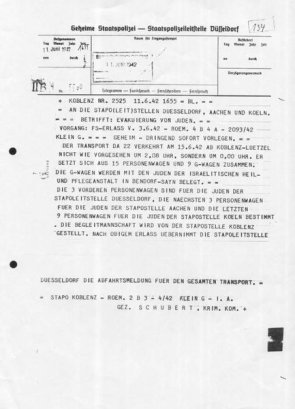
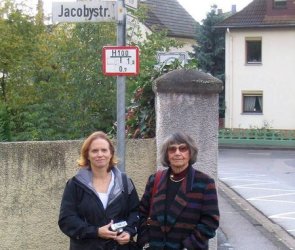
On the 17th November, 2002 a ceremony was held in front of the buildings in the Koblenz-Olper-Street 39 to unveil a public memorial (illustr. 11). The text on one of the two pillars designed by the Bendorf artist Beni Cohen-Or, and created by Hans-Joachim Hippel, a stone-mason from Mayen, reads: " Dedicated to the memory of the 573 Jewish women and men from the former Jacoby`sche Heil - und Pflegeanstalt and the town of Bendorf, who were deported to the National-Socialist extermination camps in 1942 and murdered there". The memorial was financed by donations. A plaque with the names of all those who were deported can be found in the winter garden, a connecting corridor between the two main buildings.
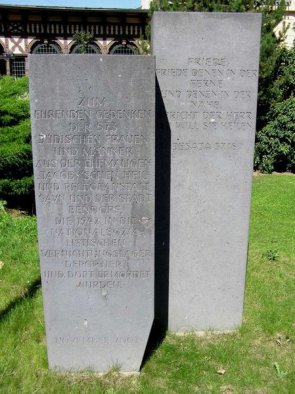
Notes:
[1] Allgemeine Zeitung des Judentums, 58th annual volume (13th July 1894)
[2] Report dealing with the Isrealit. Heil-und Pflegenastalt für Nerven- und Gemüthskranke zu Sayn, Koblenz 1890
(3) Cemetery list
[4] This was the title of the catalogue and the exhibition, which had previously been shown in the Centrum Judaicum Berlin, Oranienburger Strasse.
The accompanying publication was published by Irene Stratenwerth and the Stiftung "Neue Synagoge Berlin - Centrum Judaicum".
Illustrations:
Nrs. 2, 3 and 4 by Dr. Ingrid Schupetta, Krefeld 2006
Literature: (the titles of the publications are given in German, to facilitate thereference to them.)
Dr. S. Behrendt/Dr. S.A. Rosenthal: Israelitische Heil- und Pflegeanstalt für Nerven- und Gemüthskranke in Sayn bei Coblenz. In: Deutsche Heil- und Pflegeanstalten für psychisch Kranke in Wort und Bild. Redigiert von Dr. Johanna Bresler, Halle/Saale. 1912
Irene Stratenwerth: Leben und Sterben in Sayn. Vom Alltag einer jüdischen Nervenklinik in der NS-Zeit. In: Brückenschlag. Zeitschrift für Sozialpsychiatrie. Literatur, Kunst. Band 16 (2000).
Dietrich Schabow: Zur Geschichte der Juden in Bendorf (Broschüre), Bendorf 1979 (out of print).
Recent research has resulted in a more extensive portrayal of the history of the Jacoby`schen Anstalt.; "Die Heil- und Pflegeanstalten für Nerven- und Gemütskranke in Bendorf", published by the Rheinischen Eisenkunstguss-Museum Bendorf-Sayn 2008, 142 pages, 9,80 Euros, ISBN-Nr.: 978-3-9800158-9-9, incl: Dietrich Schabow: "Die Israelitische Heil- und Pflegeanstalt für Nerven- und Gemütskranke (Jacoby`sche Anstalt, 1869-1942) und die spätere Verwendung der Gebäude", pages 45 - 95, 26 illustrations, numerous charts and statistics. The book is available in bookshops or from the Rheinische Eisenkunstguss-Museum Bendorf-Sayn, 56170 Bendorf.
Translated by Jany Gräf
